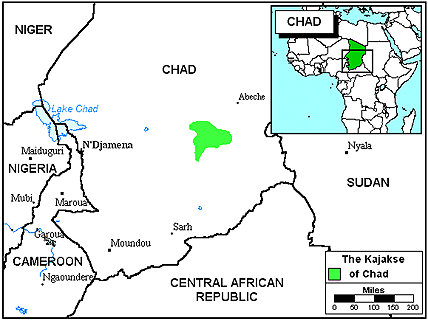The Kajakse people are in the south-central region of Chad. Many of the groups of this region share various similarities in culture and lifestyle, and it is difficult to tell them apart. Despite these likenesses, the Kajakse are aware of clan loyalties and are hesitant to intermarry with other peoples. Although they attempt to keep separate identities, the groups usually maintain peaceful relationships with one another. In the past, they have even rallied together to protect their independence from outside forces. In the past, the Kajakse and other neighboring groups were the objects of repeated slave raids by the Fulbe and Arabs. As a result, there is much bitterness against these more powerful peoples.
The Kajakse speak a Chadic language, also called Kajakse, which is from the Afro-Asiatic language family. As far as we know, there are no Christian resources available in the Kajakse language. Some Kajakse can speak Arabic, the trade language of Chad.
The Kajakse are either hunters-gatherers or small-scale farmers who attempt to cultivate the rocky, dry ground. The main crop grown is millet. The Kajakse also grow cotton, okra, beans, and corn along with a variety of fruits and vegetables. Their diet primarily consists of a heavy millet paste, eaten with a sauce made from wild leaves, meat or dried fish.
Kajakse receive income from selling surplus millet and from transporting goods for others. They trade with the nearby Arabs regularly to purchase items they cannot otherwise obtain. They trade millet for milk, meat and goods made by Arab blacksmiths.
Most Kajakse women wear colorful print fabrics, either wrapped around their bodies or tailored into dresses. They wear head coverings when they are outside their compounds. The men wear Western-style pants with shirts or long robes with or without pants.
Most of the Kajakse live in villages composed of several clans. Each clan group lives within its neighborhood of the village. Several huts housing extended family members form a compound. Each village has a chief who must settle disputes within the village. Each village also has a "chief of the land," who holds the religious power of the village. Houses in the villages take the form of round mud-brick huts with cone-shaped, thatched roofs. Those who live in towns abide in rectangular mud brick dwellings.
Many Kajakse villages have primary schools. Many children who attempt school soon drop out to help their families earn a living. Besides schools, there are other shreds of evidence of some modernization among the Kajakse. They sparingly use kerosene lanterns and flashlights in each compound. Some Kajakse own bicycles or mopeds. However, few have access to other modern needs such as electricity, clean water and health care.
The Kajakse are almost all Muslims. Most practice pre-Islamic rituals. They follow both the Islamic calendar and various life-rite ceremonies. There are only a tiny number of Christians among the Kajakse.
Islam is a religion of works based on five basic teachings or "pillars." Muslims must affirm that "there is no god but Allah, and Mohammed is his prophet." It also required them to pray five times a day, give alms to the poor, fast during the month of Ramadan, and try to make at least one pilgrimage to Mecca.
The Kajakse have both huge physical and spiritual needs. Drought is common which leads to famine and the death of the Kajakse livestock. Many children die due to the lack of clean water and vaccines. They need access to education and modern health care. Most Kajakse have never heard a clear presentation of the gospel.
Pray the hearts of the Kadakse people would be stirred to hunger after God.
Pray that family-based movement to Christ will soon transform Kadakse society, blessing them spiritually and economically.
Pray for the Lord to move in the hearts of believers to give up their own rights and sacrifice their lives to see the Kadakse people blessed by the work of Jesus Christ, the only Savior.
Pray for Kadakse decision makers to open their communities to Christ's ambassadors.
Scripture Prayers for the Kajakse in Chad.
| Profile Source: Joshua Project |











